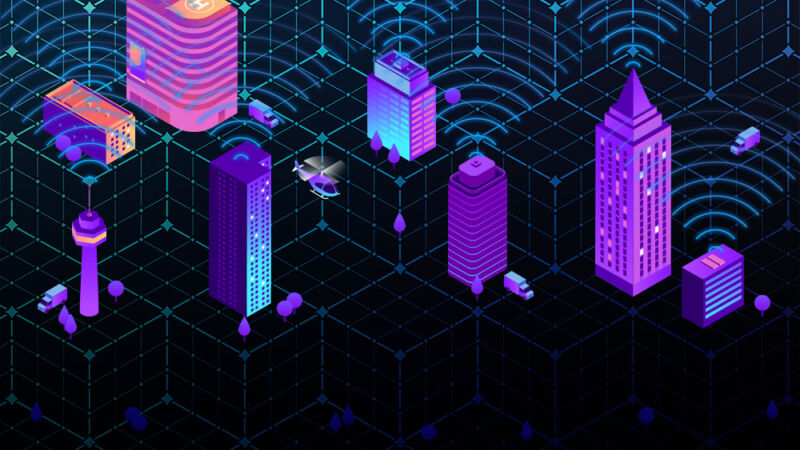
For the most part, the improvements are iterative, not revolutionary—and they're the same ones we talked about in the gaming piece. Upgraded equipment in towers means lower network latency, and mmWave connections to outside devices mean less contention for sub-6GHz devices inside buildings.

Where mmWave connections to devices are possible—which for the most part, will mean "outdoors, in high population areas"—users can expect extremely high throughput and low latency. But mmWave has far lower range and penetration than the sub-6GHz connections we're familiar with, and we don't expect indoor users to be able to get a connection. You don't necessarily need a clean line of sight to a tower—the massive MIMO antenna arrays mmWave deployments use are highly directional and can make good use of RF reflections to get around obstacles—but punching through an exterior wall to an indoor space is almost certainly too much to expect.
Remote work in the age of quarantine
Much like gamers, most teleworkers—whether they realize it or not—depend more on low latency than high throughput. While you need a high throughput (measured in Mbps, or megabits of data per second) to download a big file over the office VPN, you need consistent, low latency (measured in milliseconds) to keep a videoconference on track or to smoothly remote control a work PC from home.
While we expect most remote workers will continue to rely on Wi-Fi to get to the internet from their laptops and home PCs, many videoconference calls are made from smartphones and tablets with LTE modems. As 5G shows up on towers and in the cellular modems of new mobile devices, we can expect significant improvements in latency and throughput alike. Some of that benefit will come from improvements in the protocol itself—such as tighter control timing, designed for higher-performance chipsets in modern devices—but much of it will simply come from having more spectrum to allocate to users, resulting in more available airtime and less contention.
In fact, we can expect 400Mbps throughput on edge mmWave connections.
Higher-quality 5G cellular data connections might also make remote work more accessible to working-class people, many of whom may not have traditional Internet connections and Wi-Fi equipment, instead relying on phones or tablets as their home computing devices. Mitigating the need to invest in expensive equipment to seem "professional" can help businesses and employees alike.
Millimeter wave—now, and in the future
The really revolutionary claims we've all seen about 5G are mostly about millimeter wave—the extremely high-bandwidth, high-frequency spectrum from 24GHz to 39GHz. Millimeter-wave spectrum offers 800MHz wide channels, sub-1ms over-the-air (OTA) latency, and extremely high throughput. In fact, we can expect 400Mbps throughput on edge mmWave connections—where "edge" means "if the connection was any worse, it wouldn't be connected at all."
We're going to speculate a bit on some fascinating possibilities for mmWave in the future, but we're also going to keep things real—for the moment, end-user mmWave technology is really only in direct development for what the industry calls "enhanced mobile broadband use case." Translated into English, that roughly means "normal people, doing normal stuff on their phones."
We spoke at length to David Hall, a director at National Instruments. NI is an Austin, TX based company which is heavily involved in the testing of new RF equipment—including both Wi-Fi and cellular gear—in its design stages. While Hall is excited about mmWave, he says that the vast majority of current deployments are sub-6GHz, and he doesn't see indoor mmWave deployments as being likely any time in the near future.

Although mmWave has incredible promise, it still has some growing pains to work through, and the easiest place to work through them while the technology is in its relative infancy is outdoors, where propagation is simpler. Power efficiency is one of the larger sticking points; as Hall points out, we've been working on more and more efficient sub-6GHz handset technology since 1983, while mmWave has only had a couple of years to "bake."
Due to the extremely directional nature of mmWave connections, beamforming is also very important to the technology and is still under development. Hall described a lot of ongoing work targeting this feature—it's important to maintain connections as users move around and pass by obstacles, so phones under test get rotated on their axes and revolved around soft obstacles in RF test chambers to make certain that massive MIMO arrays can keep them targeted and connected.
Although there are still some collywobbles to work out in production, mmWave tech has incredible potential for high device density—the 256-element massive MIMO arrays being used in today's mmWave tower deployments are capable of transmitting to and receiving from up to 128 different 2x2 mmWave devices on the same channel simultaneously. This ability to avoid congestion while "talking" to so many devices at once is a large part of mmWave's promise of extremely reliable, low-latency connections.
In theory, we might eventually see indoor mmWave deployments in settings like factory floors, where sensors and robotic devices alike could benefit from real-time wireless communication with human operators and control suites while also broadcasting bucketloads of telemetry. Although it's easier to deploy standard Wi-Fi technology, Wi-Fi is less reliable—particularly in environments with extreme device density. Since airtime isn't centrally controlled with Wi-Fi, many active devices means many packet collisions, a whole lot of automated backoff-and-retry, and inconsistent latency for everyone.
In practice, that mmWave-controlled factory floor scenario probably won't be common anytime soon. In order to really take advantage of this hypothetical automated device-dense scenario, we'd be looking for IOT-grade, inexpensive mmWave radios—and Hall says NI isn't seeing devices like that under test.
The Link LonkSeptember 08, 2020 at 08:00PM
https://ift.tt/32aYAtT
Taking 5G to work, in offices, and on the factory floor—will it help? - Ars Technica
https://ift.tt/2VuKK1x
Work

No comments:
Post a Comment